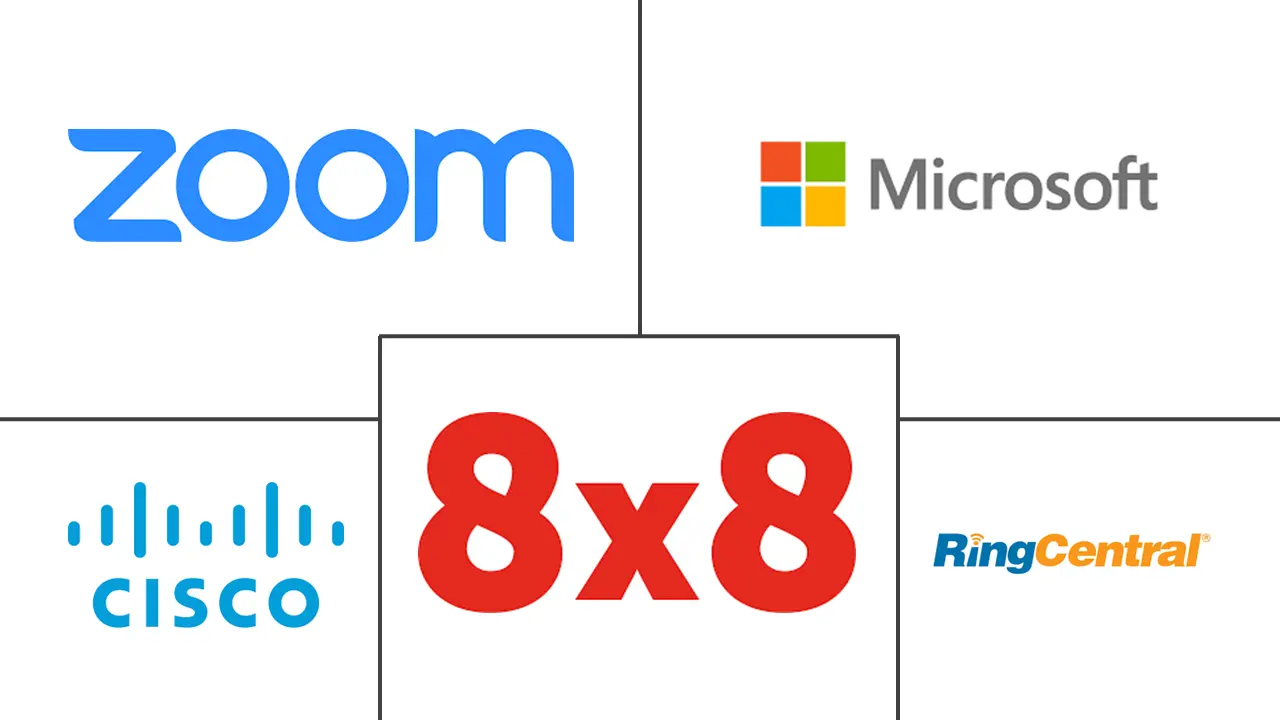Unified Communications And Collaboration Market Size and Share

Unified Communications And Collaboration Market Analysis by Mordor Intelligence
The unified communications and collaboration market stands at USD 186.05 billion in 2025 and is forecast to reach USD 634.29 billion by 2030, translating into a 27.80% CAGR. Expanding hybrid-work programs, AI-augmented productivity features, and the need to collapse disparate voice, video, messaging, and workflow applications into a single cloud environment drive this momentum. Enterprises continue reallocating digital-transformation budgets toward communication tools that raise employee engagement across distributed teams. Incumbents such as Microsoft, Cisco, and RingCentral defend share through horizontal platform depth, while AI-first challengers target niche workflow gaps. Strategic mergers—RingCentral’s USD 650 million purchase of Mitel and Ericsson’s USD 6.2 billion acquisition of Vonage—illustrate how vendors bundle unified communications with contact-center and API capabilities to widen addressable markets.
Key Report Takeaways
- By deployment model, cloud captured 65.7% of the unified communications and collaboration market share in 2024, while the segment itself is projected to compound at 29.20% through 2030.
- By component, voice/IP telephony led with 35.4% revenue share in 2024; collaboration and content sharing are expected to expand at a 27.90% CAGR to 2030.
- By organization size, large enterprises held 59.8% of the unified communications and collaboration market size in 2024, whereas SMEs record the highest projected CAGR at 28.3% through 2030.
- By end-user industry, BFSI controlled 26.9% of 2024 revenue, while healthcare and life sciences is advancing at a 30.2% CAGR to 2030.
- By geography, North America led with 25.7% market share in 2024, yet Asia-Pacific shows the fastest regional growth at an 18.7% CAGR to 2030.
Global Unified Communications And Collaboration Market Trends and Insights
Drivers Impact Analysis
| Driver | (~) % Impact on CAGR Forecast | Geographic Relevance | Impact Timeline |
|---|---|---|---|
| Hybrid-work demand accelerates UCaaS migration | +8.5% | Global, with concentration in North America and Europe | Medium term (2-4 years) |
| AI-augmented meeting productivity and automation tools | +7.2% | Global, led by North America, expanding to Asia-Pacific | Short term (≤ 2 years) |
| UC-CCaaS convergence to streamline customer experience | +5.8% | Global, strongest in North America and Europe | Medium term (2-4 years) |
| 5G and edge computing enable low-latency immersive collaboration | +4.1% | APAC core, spill-over to North America and Europe | Long term (≥ 4 years) |
| Vertical-specific workflow integration | +3.7% | Global, sector-specific concentration | Medium term (2-4 years) |
| Sustainability mandates favor energy-efficient cloud UC solutions | +2.9% | Europe and North America, expanding globally | Long term (≥ 4 years) |
| Source: Mordor Intelligence | |||
Hybrid-Work Demand Accelerates UCaaS Migration
Enterprises replacing legacy PBX systems report lower maintenance costs and improved uptime after moving workloads into Microsoft Teams Phone, achieving a 78% telecom-expense reduction at Florida Crystals Corporation.[1]Microsoft Corp., “Customer Story: Florida Crystals Reduces Costs,” microsoft.com Rising adoption rates among Canadian mid-market firms show the same trajectory, validating cloud UC for geographically dispersed staff. Providers that bundle voice, video, chat, and workflow apps on one license displace point solutions and deepen customer stickiness. The shift squeezes traditional telephony vendors that lack cloud scale, bolstering revenue for UCaaS specialists able to execute global roll-outs quickly. Larger install bases in North America mean the region remains the bellwether for new functionality introductions.
AI-Augmented Meeting Productivity and Automation Tools
Microsoft’s AI business exited Q2 2025 at a USD 13 billion annual run rate, driven by Copilot services embedded in Teams meetings, calls, and messages. RingCentral likewise monetizes AI Receptionist capabilities, crossing 1,000 customers with over USD 50 million in annual recurring revenue.[2]RingCentral Inc., “AI Receptionist Adoption Surges,” ringcentral.com Real-time transcription, multilingual translation, and automated meeting summaries move unified communications from passive connectivity to active decision support. Healthcare providers using AI call-triage features report lower no-show rates and faster response times, demonstrating tangible clinical outcomes. Competitive focus now centers on inference quality and seamless workflow integration rather than raw feature counts.
UC–CCaaS Convergence to Streamline Customer Experience
8x8 found every surveyed IT leader intends to deploy combined UCaaS plus CCaaS within two years, highlighting enterprise appetite for a single engagement stack. Central Bank’s rollout of Five9 Intelligent Virtual Agent reached an 80% intent-match rate, halving live-agent call volumes. Integrated platforms let frontline staff escalate customer issues to subject-matter experts in real time, improving resolution metrics and reducing application switching. Vendors with robust developer APIs and event architectures hold an edge because they connect contact-center data to collaboration spaces, analytics dashboards, and CRM systems.
5G and Edge Computing Enable Low-Latency Immersive Collaboration
Ultra-low latency coupled with edge compute allows immersive AR/VR sessions for design reviews, remote surgery mentoring, and industrial maintenance. Microsoft HoloLens users in Fortune 50 factories employ Pexip gateways to stream real-time visuals from shop floors, obviating travel and speeding corrective actions. Future 6G initiatives will further uplift bandwidth ceilings, pushing collaboration toward photorealistic holography.
Restraints Impact Analysis
| Restraint | (~) % Impact on CAGR Forecast | Geographic Relevance | Impact Timeline |
|---|---|---|---|
| Stringent security and compliance requirements slow adoption | -4.8% | Global, strongest in Europe and North America | Short term (≤ 2 years) |
| Legacy system integration complexity and high switching costs | -3.2% | Global, concentrated in large enterprises | Medium term (2-4 years) |
| Telecom-API commoditization squeezing provider margins | -2.1% | Global, affecting all providers | Medium term (2-4 years) |
| Regional data-sovereignty fragmentation inflates operating costs | -1.9% | Europe, expanding to APAC | Long term (≥ 4 years) |
| Source: Mordor Intelligence | |||
Stringent Security and Compliance Requirements Slow Adoption
HIPAA for healthcare, PCI-DSS for payments, and GDPR for European user data add encryption, audit, and localization layers that lengthen deployment timelines. Smarsh reinforced its compliance position by acquiring CallCabinet in February 2025, bundling AI-driven call recording and analytics into its archive platform.[3]Smarsh Inc., “Smarsh to Acquire CallCabinet,” smarsh.com Financial firms must capture every modality—voice, video, chat—for MiFID II, prompting rigorous vendor due-diligence and driving demand for specialty compliance stacks. Providers without end-to-end certifications risk exclusion from regulated tenders, limiting addressable revenue.
Legacy System Integration Complexity and High Switching Costs
Enterprises running multi-country PBX estates often stage migrations over several fiscal years, running dual environments to avoid disruption. Metaswitch users moving toward cloud calling face voicemail and device-management challenges that extend project plans Hidden costs—desk-phone write-offs, coexistence trunking, user-training—can erode near-term ROI despite compelling five-year TCO models. Systems integrators and managed service partners capitalize by offering phased cutover programs but still contend with elongated sales cycles.
Segment Analysis
By Deployment Model: Cloud Dominance Accelerates Enterprise Migration
Cloud services represented 65.7% of spending in 2024 and maintain the highest trajectory at 29.20% CAGR, making the segment the nucleus of the unified communications and collaboration market. The unified communications and collaboration market size for cloud deployments is forecast to widen sharply as companies phase out depreciated PBX hardware. Vendors continue to certify advanced encryption, sovereign-cloud options, and industry templates, convincing even regulated firms to adopt pure SaaS footprints. Conversely, on-premises and hosted models persist where air-gapped environments are mandatory, though their collective revenue contribution declines each year. Hybrid architectures gain traction by retaining critical call control on-site while bursting elastic workloads into the cloud, giving risk-averse enterprises a transition runway. Over the next five years, bundled migration tooling, zero-touch device provisioning, and per-user subscription options will further compress the on-premises share.
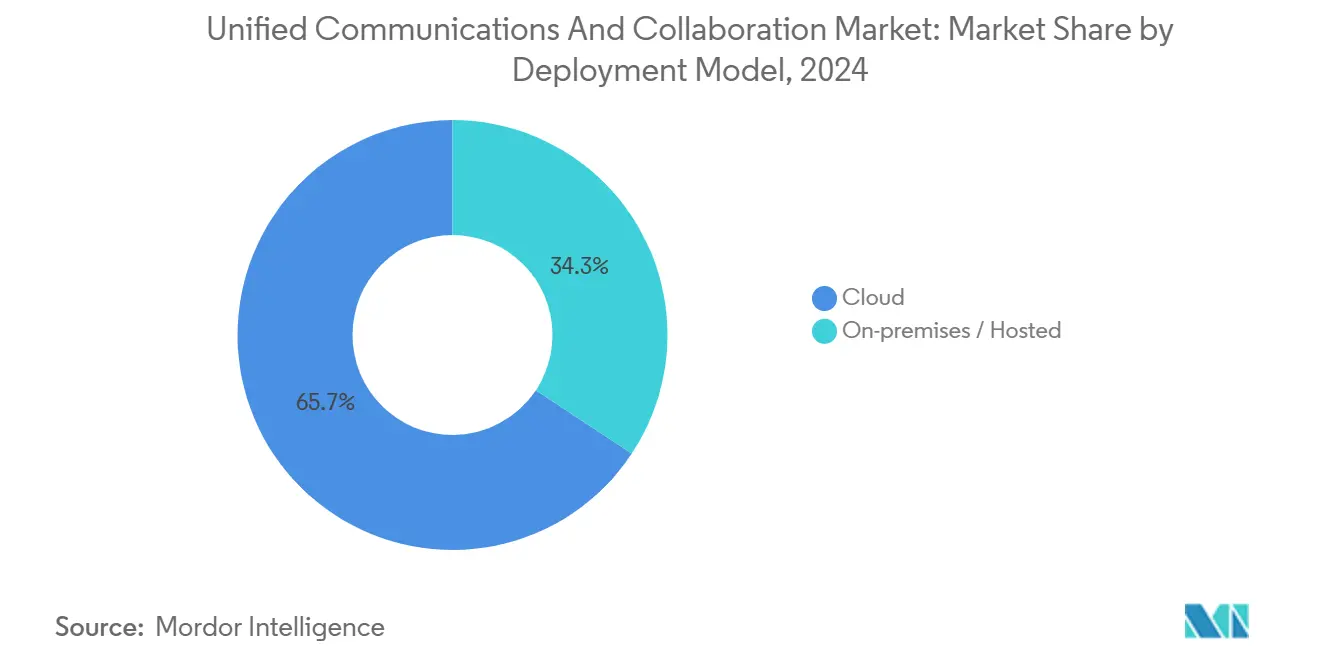
By Component: Voice Telephony Leads While Collaboration Tools Surge
Voice/IP telephony retained 35.4% revenue share in 2024, reflecting continued reliance on live conversations for sales, service, and incident response. Yet collaboration/content sharing climbs fastest at 27.90% CAGR, underscoring moves toward multitool workspaces that combine chat, co-editing, whiteboarding, and task tracking. The unified communications and collaboration market share for voice will gradually compress as organizations favor asynchronous media that integrates with business applications. Inside the unified communications and collaboration market, vendors embed document co-authoring, digital whiteboards, and persistent chat into video meetings, blurring component boundaries.
By Organization Size: Large Enterprises Dominate, SMEs Drive Growth
Large enterprises generated 59.8% of global revenue in 2024, validating the segment’s critical influence on roadmap priorities. The unified communications and collaboration market size among large organizations expands steadily as multinationals standardize on single tenants to reduce inter-continental toll charges and enforce security baselines. Procurement teams negotiate global site licenses that bundle voice, meetings, and premium security, sustaining high average revenue per user. However, SME spending posts the fastest 28.3% CAGR because simplified administration, per-seat pricing, and self-service portals lower adoption barriers.
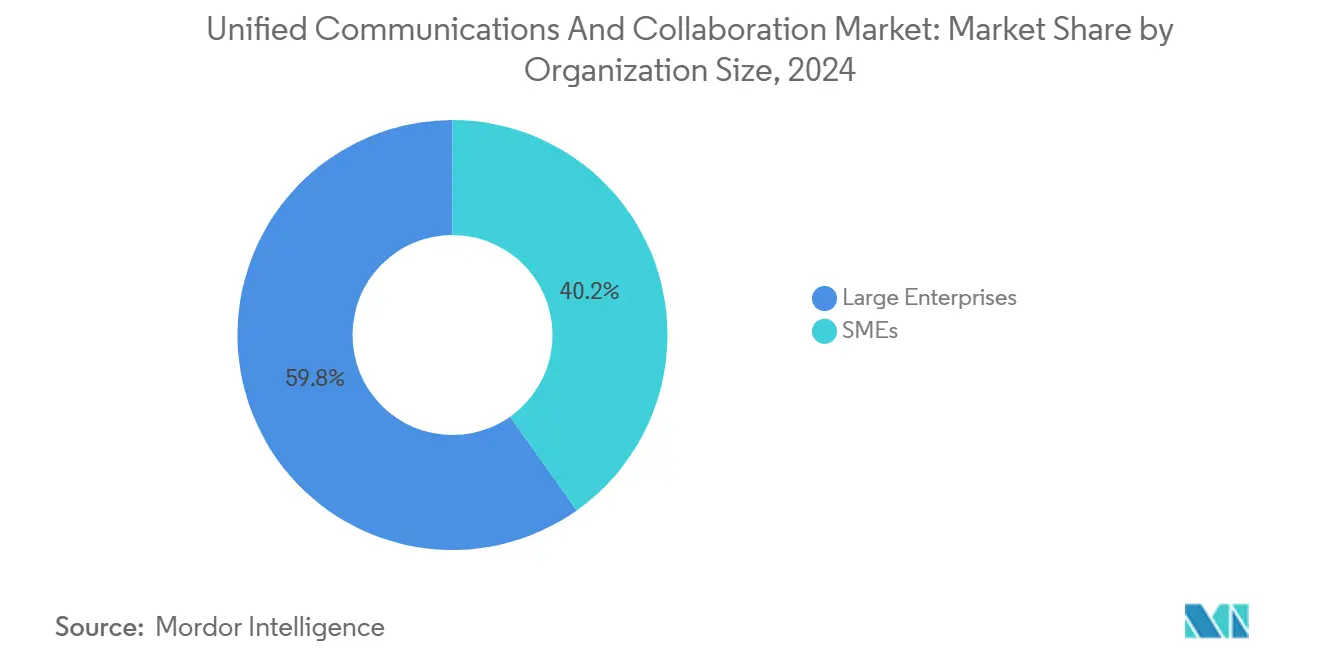
By End-User Industry: BFSI Leadership, Healthcare Acceleration
The BFSI sector accounted for 26.9% of global revenue in 2024, anchored by compliance-driven adoption of integrated voice recording, chat archiving, and secure video consultations. Banks deploy UC–CCaaS convergence to connect branch experts with digital customers, improving cross-sell rates and service KPIs. In contrast, healthcare and life sciences book the fastest 30.2% CAGR, leveraging HIPAA-compliant video, AI triage assistants, and EHR integrations for telehealth and care coordination. The unified communications and collaboration market size within healthcare is poised to climb as payer reimbursement frameworks normalize virtual visits.
Retail and e-commerce embrace omnichannel engagement that fuses storefront staff, fulfillment hubs, and customer-care agents in one cloud tenant. Public-sector entities adopt UC to sustain hybrid service desks and distance-learning programs while adhering to accessibility standards. Manufacturing and logistics firms emphasize mobility, rugged device support, and edge interoperability to monitor production lines and fleets. Vertical nuances therefore shape feature roadmaps, integration priorities, and partner ecosystems.
Geography Analysis
North America contributed 25.7% of 2024 revenue, underscoring its role as the primary R&D and early-adopter region for unified communications platforms. U.S. enterprises accelerated cloud migrations as Microsoft’s commercial cloud sales surpassed USD 42.4 billion in Q3 2025, up 20% year over year. Canadian mid-market adoption tops three quarters of medium-sized firms, reflecting favorable broadband penetration and distributed workforce patterns. Mexico’s near-shoring manufacturing boom increases cross-border collaboration demand, encouraging Spanish–English language services within UC suites.
Asia-Pacific is the fastest-growing territory at an 18.7% CAGR. China’s cloud-communications vendors benefit from state-backed 5G roll-outs and enterprise digitization drives, although data-sovereignty rules favor domestic hosting partners. Japan’s 5G investment roadmap, targeting JPY 4.362 trillion (USD 0.031 trillion) in telecom equipment sales by FY 2026, signals sustained spending on immersive collaboration infrastructure. India’s Bharat 6G alliance, supported by government memoranda of understanding with the United States and others, aims to leapfrog high-bandwidth application readiness, enhancing long-term TAM for UC vendors.
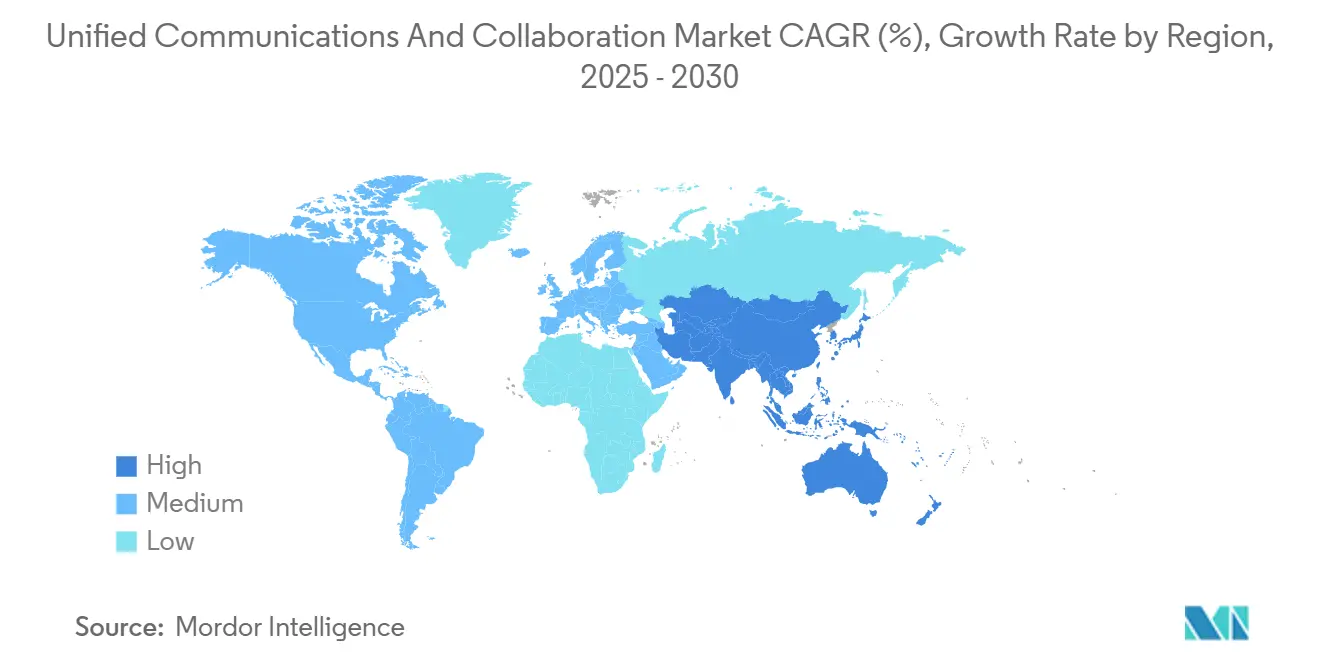
Competitive Landscape
Platform heavyweights shape pricing and feature trajectories. Microsoft leverages its Office 365 estate to embed Teams telephony, reporting USD 13 billion AI revenue and USD 42.4 billion cloud sales in 2025, both propelling upsell velocity. Cisco competes on enterprise-grade security, adding Apple Vision Pro and AirPlay support to Webex Rooms in March 2025. RingCentral remains the leading pure-play UCaaS provider, disclosing USD 612 million Q1 2025 revenue and integrating Mitel assets to strengthen mid-market voice portfolios.
Acquisitions accelerate portfolio breadth: Ericsson bought Vonage for USD 6.2 billion to mesh UC with CPaaS APIs and 5G edge services. Smarsh expanded compliance coverage via CallCabinet, signaling rising importance of voice analytics in regulated industries. Proximus Global merged BICS, Telesign, and Route Mobile, forming a CPaaS heavyweight with reach into messaging, voice, and verification.
Unified Communications And Collaboration Industry Leaders
-
Microsoft
-
Cisco Systems
-
Zoom Video Communications
-
RingCentral
-
8x8
- *Disclaimer: Major Players sorted in no particular order
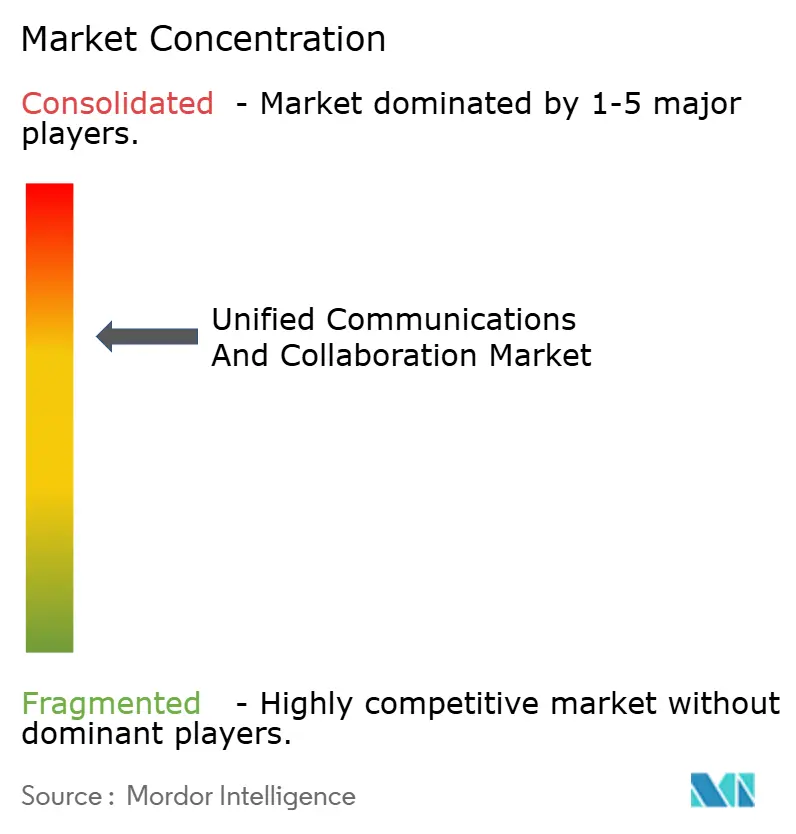
Recent Industry Developments
- June 2025: Vodafone and Three finalized their merger, creating the United Kingdom’s largest mobile network and expanding 5G-powered UC coverage.
- May 2025: India’s Bharat 6G Alliance signed research pacts with the United States, South Korea, and Germany to accelerate 6G collaboration.
- April 2025: Microsoft unveiled Teams “Chat @nearby,” AI meeting recaps, and 50,000-attendee town-hall support at Enterprise Connect 2025.
- March 2025: Cisco announced AirPlay and Apple Vision Pro support for Teams Rooms and introduced Webex Spatial Meetings.
Global Unified Communications And Collaboration Market Report Scope
Unified Communications and Collaboration (UC&C) is a group of solutions organizations implement to ensure that nearly all their technology works smoothly and securely for near real-time collaboration. It is beneficial to integrate multiple enterprise communication tools such as voice calling, video conferencing, instant messaging (IM), presence, content sharing, etc.
unified communications market is segmented by deployment type (on-premise/hosted, cloud), type (business VOIP/UC solutions, enterprise collaboration, contact center services, customer interaction applications), end-user vertical (retail, BFSI, healthcare, public sector) and geography (North America, Europe, Asia-Pacific, Rest of the World (Latin America and Middle East & Africa). The market size and forecasts are provided in terms of value (USD) for all the above segments.
| On-premises / Hosted |
| Cloud |
| Voice / IP Telephony |
| Video Conferencing |
| Messaging and Presence |
| Collaboration/Content Sharing |
| Others |
| SMEs |
| Large Enterprises |
| BFSI |
| Healthcare and Life Sciences |
| Retail and E-commerce |
| Public Sector and Education |
| IT and Telecom |
| Manufacturing and Logistics |
| North America | United States | |
| Canada | ||
| Mexico | ||
| South America | Brazil | |
| Argentina | ||
| Rest of South America | ||
| Europe | Germany | |
| United Kingdom | ||
| France | ||
| Netherlands | ||
| Rest of Europe | ||
| Asia-Pacific | China | |
| Japan | ||
| India | ||
| South Korea | ||
| Australia and New Zealand | ||
| Rest of Asia-Pacific | ||
| Middle East and Africa | Middle East | United Arab Emirates |
| Saudi Arabia | ||
| Turkey | ||
| Rest of Middle East | ||
| Africa | South Africa | |
| Nigeria | ||
| Rest of Africa | ||
| By Deployment Model | On-premises / Hosted | ||
| Cloud | |||
| By Component | Voice / IP Telephony | ||
| Video Conferencing | |||
| Messaging and Presence | |||
| Collaboration/Content Sharing | |||
| Others | |||
| By Organization Size | SMEs | ||
| Large Enterprises | |||
| By End-user Industry | BFSI | ||
| Healthcare and Life Sciences | |||
| Retail and E-commerce | |||
| Public Sector and Education | |||
| IT and Telecom | |||
| Manufacturing and Logistics | |||
| By Geography | North America | United States | |
| Canada | |||
| Mexico | |||
| South America | Brazil | ||
| Argentina | |||
| Rest of South America | |||
| Europe | Germany | ||
| United Kingdom | |||
| France | |||
| Netherlands | |||
| Rest of Europe | |||
| Asia-Pacific | China | ||
| Japan | |||
| India | |||
| South Korea | |||
| Australia and New Zealand | |||
| Rest of Asia-Pacific | |||
| Middle East and Africa | Middle East | United Arab Emirates | |
| Saudi Arabia | |||
| Turkey | |||
| Rest of Middle East | |||
| Africa | South Africa | ||
| Nigeria | |||
| Rest of Africa | |||
Key Questions Answered in the Report
What is the current value of the unified communications & collaboration market?
The market generates USD 186.05 billion in 2025 revenue and is tracking toward USD 634.29 billion by 2030.
Which deployment model is growing fastest?
Cloud services record a 29.20% CAGR, outpacing on-premises and hybrid alternatives.
Which region will see the highest growth through 2030?
Asia-Pacific leads with an 18.7% CAGR, supported by extensive 5G roll-outs and government digitalization programs.
Why is healthcare adoption accelerating?
HIPAA-compliant video visits, AI triage tools, and integration with electronic health records propel a 30.2% CAGR for healthcare & life sciences.
Page last updated on:
